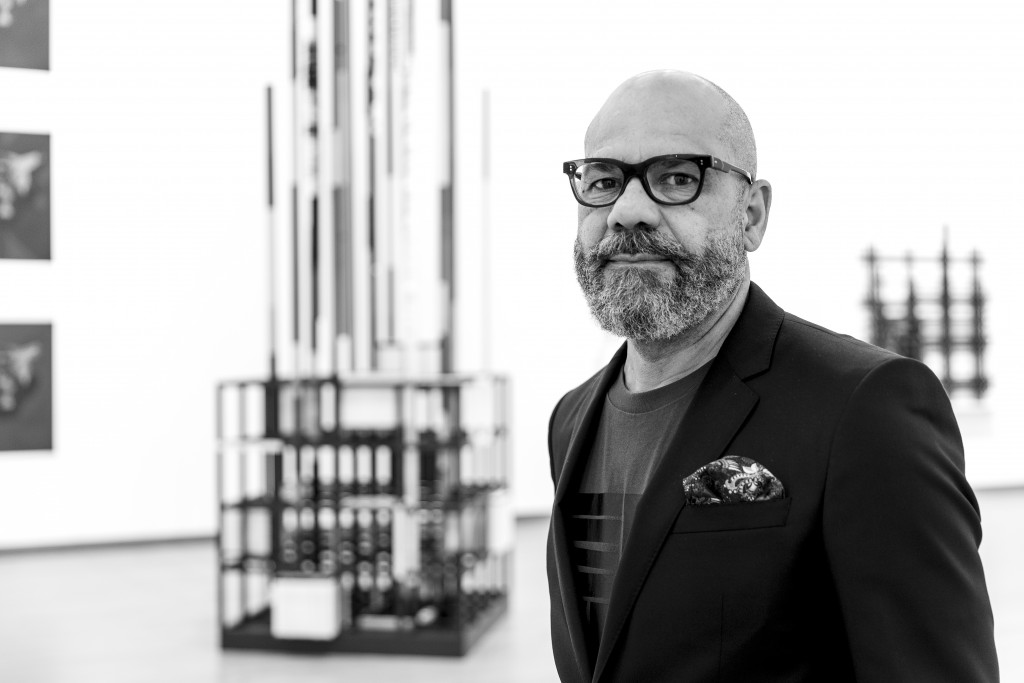Acquisition and donation for Stedelijk Museum Amsterdam by Remy Jungerman
News — May 18, 2022
The Stedelijk closes the successful solo exhibition Remy Jungerman. Behind the Forest with a generous donation from the artist: his first monumental cube work FODU. Ultimate resistance. With the support of its patrons, the museum also acquired a large panel for its collection Pimba AGIDA KAA II. Both works engage in dialogue with works of De Stijl, constructivism and minimalist art, among others, in the Stedelijk’s collection.


Donation
FODU. Ultimate Resistance (2014) Jungerman’s first cube sculpture, has been donated to the museum. The work features two cubes placed one on top of the other, with a slight gap between them, covered with fabric (one red with white polka dots, the other a Vlisco fabric with a snake motif) and partially coated with kaolin, a fine type of clay mined in Moengo in Suriname, where Jungerman was born. This cube work was followed by others, which also, despite the austere geometric form, refer to Afro-religious contexts. White kaolin is used in the Winti religion for its purifying properties, the nails symbolize spiritual power and the bottles and shards of a jenever jar reference libations.
Acquisition
Thanks in part to the generous support of patrons, the Stedelijk was also able to purchase Pimba AGIDA KAA II, the second painted artwork by Jungerman in the Stedelijk’s holdings and an important addition to the sculptural works the museum has in its collection. The vertical wooden panel is pasted with several rectangular pieces of textile, which have been pre-treated with kaolin, and notched. The edges of the strips of textile are still visible, forming the vertical pattern on the panel. The work is strongly reminiscent of minimalist art from the 1960s, but the oozing colors of the textiles give new meaning to the grid pattern. Pimba AGIDA KAA II is the second panel of a total of seven panels made in 2020 and 2021.
“Remy Jungerman works at the intersections of Surinamese Maroon culture, the African Diaspora and 20th century modernism. He searches for an autonomous visual language by allowing abstract geometric patterns from disparate cultures to enter into conversation. For him, the creative process is a ritual act: sometimes he places pieces of fabric in a cube, sometimes memories or emotions. He provides them with a content that is not visible, but palpable. It is extraordinary that his work at the Stedelijk enters into a dialogue with the modernist aesthetics of movements such as De Stijl, constructivism and minimalist art. In doing so, he adds a new layer to the Western canon and challenges established art history. We are delighted by the artist’s generosity, and proud to be able to complement his gift with an acquisition.”
Behind the Forest
The exhibition Behind the Forest, on display at the Stedelijk until 10 April, presented an exhaustive survey of Jungerman’s work over the last fifteen years and was acclaimed by press and public alike. De Volkskrant awarded the exhibition 4 stars (“Jungerman shows himself to be a master of the remix at the Stedelijk in Amsterdam”), visitors called his work “impressive,” “layered” and “personal”. The exhibition was given extra depth with the online tour in which Jungerman talked about his work and a special edition of Meet the Masters, an evening in which he explained his working process, use of materials and stories behind the objects.
About Remy Jungerman
Remy Jungerman (1959) lives and works in the Netherlands and the United States. He attended the Academy for Higher Art and Culture Education in Paramaribo and moved to Amsterdam in 1990 to complete his training at the Rietveld Academy in Amsterdam. Jungerman’s mother was of African heritage, his father of European descent. In 2005, his father died, and Jungerman returned to Suriname for the funeral. While there, he also visited his mother’s family altar and took part in ancestor worship rituals. Jungerman’s mother is a descendant of the Bakabusi (‘the people behind the forest’) who escaped enslavement on Dutch plantations and founded their own community in the Surinamese rainforests. The exhibition title Behind the Forest, pays homage to this piece of history. Jungerman honors his indebtedness to the culture of the Maroons through the act of creating. In 2020, Remy Jungerman represented the Netherlands at the 58th Venice Biennale with Iris Kensmil. There, he exhibited the installation Visiting Deities, which made its Dutch debut in Behind the Forest.

Pimba AGIDA KAA II (2020) by Remy Jungerman is acquired with the generous support of Marjo Meijer and Marion Verbruggen and the Vriendenloterij.

